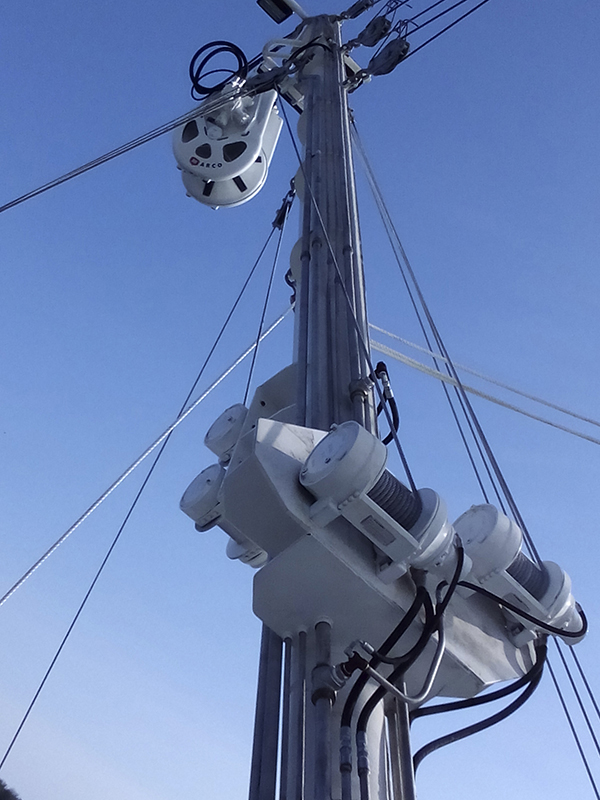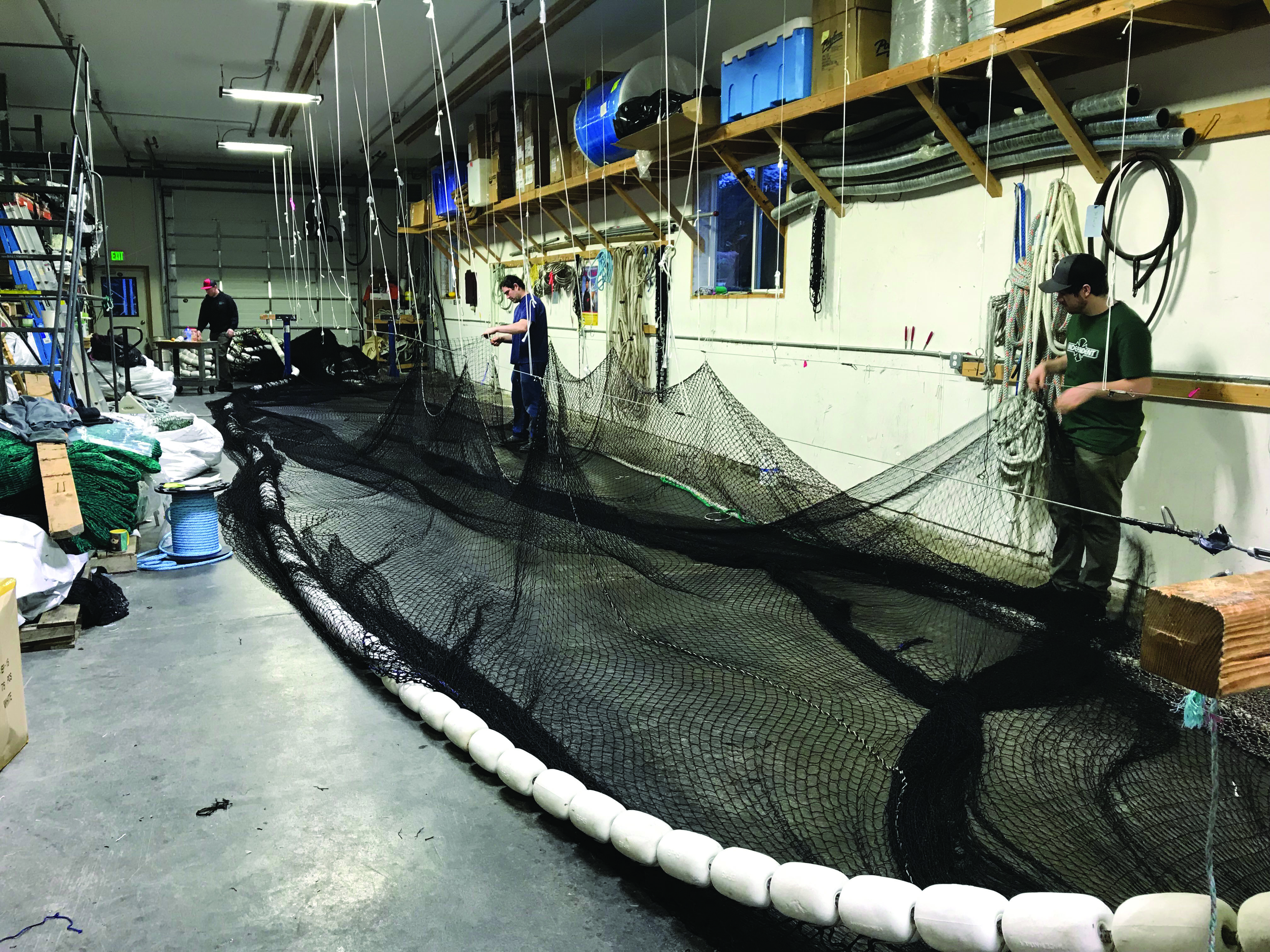While the earliest incarnations of trawling can be traced back to the 1700s, the earliest versions of seine fishing are depicted on Egyptian tombs from 5,000 years ago. With advances in net technology, sensors and haulers, there is nothing primitive in the way seiners operate today.
Barry Matthews comes from a purse seining family on Canada’s Campobello Island, just across the international bridge from Lubec, Maine.
“Ivan (Matthews) practically invented it,” says Matthews, who launched his boat, the Ocean Venture, six years ago and bought a powerful seine skiff built in Seattle.
Things have changed since Ivan’s day. “I buy twine in bales from another country,” says Matthews. “They come in 50-fathom sections, and we put them together. The biggest we use is 400 fathom, 200 meshes deep, about 60 fathom. They’re a lot bigger than what we used to use. Used to be 6 pounds per fathom, now it’s 20-25 per fathom. We’re using 3/4-inch cable.”
Matthews talks about the greater weight of the nylon seines he hauls aboard, but Menon “Gopa” Gopakumar, of the India-based fiber producer Garware Technical Fibres, is excited about new fibers for nets.
“The typical seine is made of twisted nylon, which is very strong. But when it gets wet, it gets heavier, so the more sets a captain makes, the heavier it gets.” Gopakumar points out that increasingly heavy twine makes handling it harder and also adds a safety concern regarding the reduced breaking strength of wet nylon — 10 percent — and the changes a waterlogged net can make to a vessel’s center of gravity.

“Polyethylene is lighter, and it doesn’t absorb water,” says Gopakumar. “But it floats. We have a fiber available called Plateena. It’s made from a DSM Dyneema, that is coated or impregnated with other material to help it sink. It’s thinner and stronger than nylon. It’s actually been around a while, but it costs three to four times as much as nylon.”
According to Gopakumar, new fibers can drastically reduce the weight of seines.
“We sell to the menhaden seiners, Omega Protein,” adds Gopakumar. “And we are selling to the seine makers in Seattle, like LFS.”
Matthews is sticking with nylon for now, but he is taking advantage of new electronics.
“They’ve got a machine now that will tell us how the tide is running at different depths,” he says. “We put Simrad eggs on the net, one forward, one in the middle and one after the hook — at the end.”
The Simrad eggs Matthews refers to are the Simrad PX seine sounders. The Simrad system receives information from up to six sensors at the same time. The system uses a hull-mounted or over the side hydrophone.
“The net’s depth, water temperature and the important bottom contact information from both pressure and acoustic signals are displayed in large digits or easy to understand graphics,” says Mike Hillers at Simrad USA. “It’s one of our simpler systems. The small size, quick update rate, long battery life and its long-range capability allows the PX system to be installed on any size net, from a small sardine net to a large tuna net. In addition, the PX system interfaces to the latest professional Simrad echo sounders and sonars, enabling this information to be viewed on the same screen.”
Several other manufacturers produce sensors for purse seines, among them Marport and Notus.
Marport’s Side Looking Seine Sounder can see both vertical to bottom and horizontal into the seine net. Captains can now watch the rate of descent. The horizontal (side looking) beam is used to visualize the depth that the school of fish begins and the depth the school of fish ends. Combined with target strength values, the side looking image will allow the captain to better estimate tonnage.
Complemented by the down-sounder functionality, this sensor also monitors the seafloor as it approaches, as well as observes fish targets as they are diving to escape.
“This gives captains a real-time presentation of what is happening with the fish in the net so they can react instantaneously,” says Marport’s Patrick Belen.
The Marport sensors also provide temperature, depth, rate of decent, and battery life information. Adding more depth and rate-of-descent sensors, a captain can monitor each part of their seine net, observing and reacting to undercurrent sweep. Temperature can reveal and help determine where there are optimal thermoclines to fish.
The design of the Notus Seinemaster monitoring system is based on more than 25 years of experience making sensors.
“It’s a great kit for real-time wireless information on seine depth,” says Francis Parrott, marketing manager at Notus. “Especially for salmon seiners who might tow the seine. They can lose fishing area, but with the Seinemaster system, they can see the depth of the net at all times.” Parrott notes that with the real-time information delivered by the Seinemaster, fishermen can maximize the fishing area of their nets at all times.

David O’Neill has worked with Matthews and many others in purse seine fisheries all around the world. His company, Gannet Nets, focuses on building better purse seines for the specific needs of customers.
“I’ve worked in every aspect of this industry,” says O’Neill. “I fished in Alaska; I’ve been a sonar operator; and I worked in R&D for Garware. When Dyneema came out, I said, ‘This is the future.’” According to O’Neill, super strong fibers like Dyneema can reduce net weight and volume by as much as 66 percent, giving fishermen faster sink times and allowing smaller boats to carry more twine, among other things.
“But when you make a dramatic change in the net, it affects the entire system,” O’Neill says. “The system is the seine, the hauler, the electronics and the crew. When you modify one part of the system, you have to make adjustments in the others.” To that end, O’Neill conducts as much research and development as he can. Setting nets with as many as a 30 sensors, he sometimes hangs over the side of the boat with his hydrophone in order to collect the data he needs to design nets that will sink faster and purse deeper.
“Thirty sensors give you a lot of information, but that’s what you need to really see what the net is doing,” he says. “When you first look at it, it’s page after page of numbers on an Excel spreadsheet. I’m lucky to have a uniquely skilled person to help me.” O’Neill recently worked with a tuna seiner captain in San Pedro, Calif.
“We went and set his old net, then we set the new one. At first, he was seeing parts of the net coming up while he was pursing. We found it was purse rings getting stuck on the connectors on the purse line. He was using the old-style rings at the time. But he switched to the new ones, Rings around the World.”
O’Neill is also working on a new hauler design that will accommodate the lighter, stronger netting he is promoting, but he is keeping a lid on that until it’s ready. “Talk to me again in the spring,” he says.
Matthews uses a couple of different power blocks to haul his net back. “I usually use a 40-inch Westec, that’s the diameter of the sheave. And it’s got a wheel on it that helps the twine stay in the block. But there’s others like Marco. They make them for the tuna fishing, and we just get ’em from them.”
The Westec block Matthews uses has not changed much over the years. “They were overbuilt back in the day,” says Westec owner Richard Sikich. “They’re rugged and reliable, we get them back here for service, some 40 years old. Our customers tell us they’re happy.”
Marco Puretic Power Blocks come in a wide variety of models with sheave diameters from 19- to 90-inch. They are made in three basic configurations: fixed side-shell with pin connected yoke; open-side-shell that swings out to insert the net; and open topped, suspended from one side. The Marco power block can be also fitted with the exclusive Power Grip which reduces net slippage during hauling.
Kolstrand makes a 26-inch Power Block with a yoke-mounted PowerGrip and hydraulic swivel arrangement. It features a bolt-in replaceable rubber cleat sheave (which allows the fisherman to change-out the worn rubber cleats in-the-field), super-strong sheave and sideshell castings. Additionally, the Kolstrand 26-inch Power Block comes with Kolstrand’s bearing supported pinion gear arrangement (which eliminates motor shaft deflection under load and creates a permanent grease barrier to protect the motor shaft from corrosion issues). Haul your net from either rail without kinking the hoses, and never worry about a leaking motor shaft seal again.
Matthews has a 450-hp John Deere engine dedicated to running the Ocean Venture’s hydraulics. “It runs a 30-gallon main pump and a couple of 20s,” says Matthews. “It’s plenty for the block.”
Various sectors of U.S. fisheries using seines are seeing different degrees of success and sustainability. While salmon and menhaden seiners are seeing steady landings and reasonable prices, tuna seiners in the Pacific dropped from 37 vessels in 2016 to 24 in 2020, and herring seiners like Matthews have seen 90 percent cuts in quota.
Matthews has continued to fish profitably by targeting menhaden off New Jersey. But he is furious with the quota cuts. While midwater trawlers can exploit available quota in the deeper waters of Georges Bank, Matthews, as a seiner, is pretty much stuck in the nearshore area, where quota has tightened.
“And we are the cleanest fishery,” he says, noting that if a catch is not what the market wants, they can let the fish, or any bycatch, go alive.
Seining is an ancient way of fishing, but many technical advances, from twine to haulers and sensors, are making it more efficient.







